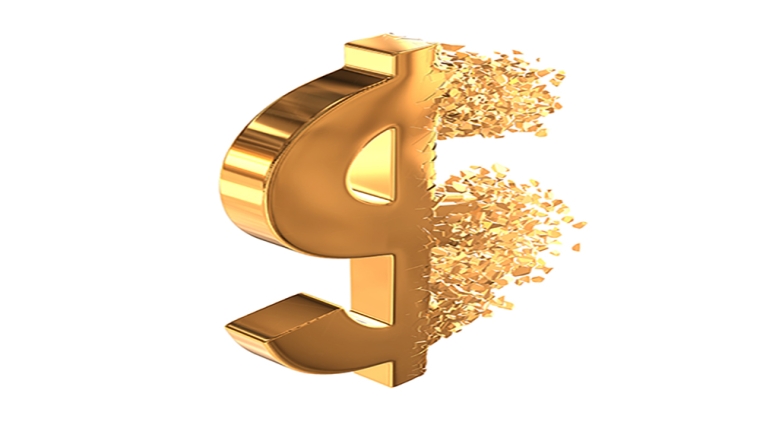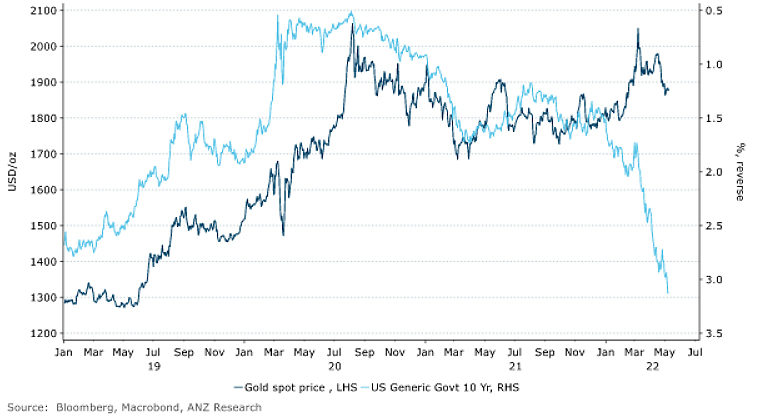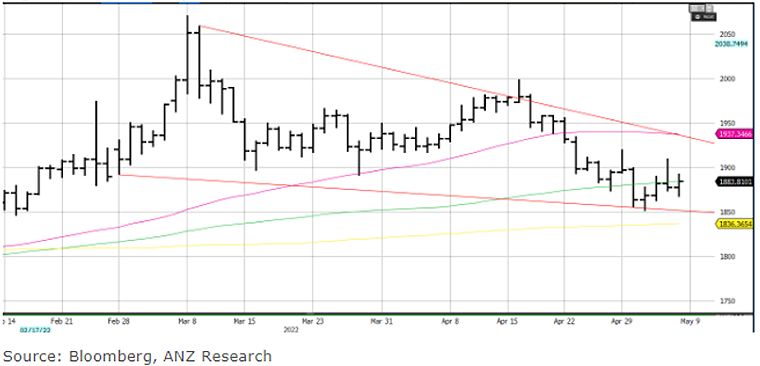
By Daniel Hynes and Soni Kumari*
Highlights
• Investor demand for gold is strong, amid heightened geopolitical risks.
• We see gold continuing to be a good hedge against inflation.
• Prices are sitting in a neutral zone of USD1,920–50/oz. A break above USD1,960/oz would be a bullish signal.
Outlook
Aggressive monetary tightening, rising yields and a stronger dollar are key drags for the gold prices. Rising inflation failed to impress the market, instead raising fears of a more hawkish stance by the central banks. That said, the spread between the fed funds rate and CPI is at its widest, suggesting the Fed is struggling to contain inflation.
Concerns about global economic growth, fueled by sustained inflation and heightened geopolitical risks, should protect the gold price somewhat. We expect gold to remain supported at USD1,850/oz, with upside potential of USD1,950/oz.
Investment demand has suffered recently, with investors liquidating nearly 23t since late April. Net-speculative positions have lost241t since early March. Investors are both liquidating long positions and adding fresh short positions. The short term is looking challenging as there is still room for further selling.
Higher prices and economic growth concerns are weakening physical demand. India’s gold imports fell to 16.5t in March, and soaring inflation could have a negative impact on gold jewelry demand. Lockdowns in major cities of China is also likely to cause suppress demand.
Figure 1. US 10y Treasury yield rose to its 2018 level

What are the major risks for the gold price?
Aggressive Fed rate hikes, faster quantitative tightening, the stronger US dollar and any possible easing of Russia’s invasion of Ukraine are the main possible headwinds for the gold prices. The US 10y yield rose to its 2018 high, reducing gold’s investment appeal. We expect the Fed to hike rates with 50bp hikes in both June and July, taking the terminal rate to 3.75% by mid-2023, above our estimate of neutral (2.5%–3.0%).
Higher inflation risks and lingering geopolitical tension are likely to offset some of these risks. The key development to watch is the Fed’s reaction to any upside surprise in inflation, which could impact real interest rates.
Is there further downside risk to gold prices in Q2?
We expect downside risks to be limited after the price hitsUSD1,850/oz. Sustained geopolitical risk and elevated inflation have been supportive factors. The uncertainty facing the euro area economy is intense, given elevated energy costs and uncertain gas supplies, plus rapidly accelerating inflation. Further, corrections in equity markets amid the uncertain economic backdrop will benefits gold’s status as a risk diversifier. Gold looks well supported at USD1,850/oz in the short term.
Have gold prices largely given up the geopolitical risk premium?
While the war in Ukraine drags on, geopolitical tension will remain a risk. The European Union’s bans on oil and gas imports from Russia could not only tighten supplies for energy but impact the broader commodity complex. This, in turn, could trigger protectionism, further disrupting commodity supply chains. So the ongoing risk is likely to support gold’s appeal as a safe haven asset.
How does investment demand look for rest of the year?
Investment flows have eased recently as headwinds have strengthened. After starting the year strongly, ETFs outflows have been 24 tonnes since late April, down from the peak of 3,329 tonnes. Investors have been liquidating futures positions, and there is room for further liquidation if bearish market sentiment dominates.
We expect investment demand to be guided by geopolitical and inflation risks. Should the Fed tighten monetary policy more than expected and geopolitical risks escalate, demand may take a hit. However, risks to the economic outlook could offset those headwinds and support investment demand later this year.
Is lacklustre physical demand a cause of concern?
Physical demand (jewelry and industrial) weakened by 3% in Q1 2022 due to higher prices and China’s lockdowns. Jewelry demand in India and China together fell by 15% y/y in Q1. A resurgence of COVID-19 cases in China, a deteriorating global economic outlook and higher prices are the key headwinds for physical consumption. We downgraded our 2022 jewelry demand growth expectation to 1%y/y from earlier estimates of 5%y/y. High prices in March discouraged Indian gold imports which fell to16.7tand are likely to remain muted given that fuel prices adding to import costs. COVID-related lockdowns in China are likely to subdue demand for the short term. It is, however, investment demand that really guides the gold market.
What would motivate central banks to purchase more gold?
Central banks tend to diversify their foreign currency reserves during crises, increasing their gold buying. De-dollarisation (a move away from the US dollar) has been driving central bank purchases in recent years, with China and Russia buying more gold. Russia holds 21% of its reserves in gold. Further sanctions could trigger more gold purchases by central banks.
Upside pressure to build up
The prospect of an aggressive fed rate cycle has seen the USD rally and bond yields rise, triggering a fresh round of gold selling. Prices have recently fallen below the 100-day moving average. Gold found some relief after the Fed took a rate hike of 75bp off the table, pushing prices back towards USD1,900/oz. We see the short-term key support level being USD1,850/oz. Should it break below this, prices could easily retreat to USD1,800/oz.
Nevertheless, we see a falling wedge formation on the chart starting from early March, which suggests bearish momentum is fading. Prices have hit a lower bound of USD1,830/oz, and we expect a trading range of USD1,850–1,930/oz in days ahead. A convincing break of above the upper trend line of USD1,930/oz would confirm a bullish move. Once this level breaks, prices could touch the previous highs of USD2,000/oz and USD2,050/oz.
Figure 2.Gold daily technical chart

Daniel Hynes and Soni Kumari are commodity strategists at ANZ. This article is a re-post from ANZ and is here with permission.
![]() Our free weekly precious metals email brings you weekly news of interest to precious metals investors, plus a comprehensive list of gold and silver buy and sell prices.
Our free weekly precious metals email brings you weekly news of interest to precious metals investors, plus a comprehensive list of gold and silver buy and sell prices.
To subscribe to our weekly precious metals email, enter your email address here. It's free.
Comparative pricing
You can find our independent comparative pricing for bullion, coins, and used 'scrap' in both US dollars and New Zealand dollars which are updated on a daily basis here »
Precious metals
Select chart tabs
19 Comments
Let's de-dollarise... to a gold standard
It could be called...Goldcoin...or Auriferum. People may even consider it a store of value & a medium of exchange.
Let's find a few trustworthy people to administer it, call it "Goldcorp" or such-like. Has a ring to it.
Stupid idea, it already failed last time because you have to trust that your paper currency is actually backed by gold in a vault somewhere. Again leading to centralisation and excess creation of paper money with no actual backing.
Bitcoin Fixs This.
No centralised control that can alter the creation of coins and trustless as the code is enforced by a mixture of nodes all around the world and the miners who also provide security for the system.
It is tripple entry book keeping and a significant advancement in accounting technology, everybody can see that no one has cheated and created more coins out of thin air. 1 BTC = 1 BTC.
Globally accessible by anyone with a cellphone and internet connection with no third party limiting who you can send your money to.
And the lightning network can be used for instant settlement on amounts less than 1c
Bitcoin is inevitable.
What's your thoughts on the likes of Pax Gold Gally? I don't own any but I have Perth Mint Gold Tokens. Not particularly liquid.
I know I am a basic thinker, but be it gold or any other investment, and that includes property, it always comes down to what it is worth in the currency of where you live. So to my mind I only invest in what I know. If I could hold gold safely at home, knowing it was pure gold, maybe I would buy some. But on a piece of paper or even worse on an email aaah maybe not thanks. Bitcoin? way out of what I would consider safe. But maybe I am to conservative. Anyway it always has to come back to what I can cash this investment into my currency. So Fiat wins.
A system where a coin similar to the old 50c piece had a 1g piece of gold (~1mm x1mm x 0.5mm) embedded in it's centre could work. That would be worth ~$100. Then you'd just need to bring down the price of gold testing machines so that every shop could have these in place/added to EFTPOS machines. Food for thought.
I visited a hotel in Abu Dhabi once many years ago which had an ATM in its foyer that discharged gold coins and bars
A friend's aunty used to work there. On each return trip home she would be weighed down with thick gold chains..."jewellery" that was really just cross-border movement of gold to convert.
Figure 1 (above) is deceptive. The graphs are going in opposite directions giving the impression of a divergence between the 10 yr and gold spot price.
A yield graph with a reversed axis is basically a price graph, this is showing it correctly.
A strong US dollar is your friend if you hold gold. It has been the perfect shock absorber, resulting in the NZ$ price hardly moving amidst the market volitility.
Bitcoin has a crystal clear graph which crypto fans need to pay attention to. Over the last month it had been lacking noticably in momentum and a glance at the 5 year graph revealed the underlying weakness. There are rather stand-out targets for BTC, US$ mid 20,000, then US$10-12,000. So it's back to pre-lockdown price.
Gold is cyber-attack proof and central banks just keep buying it.
Bitcoin has a crystal clear graph which crypto fans need to pay attention to. Over the last month it had been lacking noticably in momentum and a glance at the 5 year graph revealed the underlying weakness. There are rather stand-out targets for BTC, US$ mid 20,000, then US$10-12,000. So it's back to pre-lockdown price.
You base the future performance of ol' ratty on a single month? While those price targets are more than possible, not sure how you come to these conclusions.
You can own gold and ol' ratty. It's not either / or.
Hi. Thank you for asking a good question. While I have never owned any crypto, I have followed the market daily for 10 years as an unemotional spectator and analyst. The last month has been unusual in that time frame of 10 years as BTC and prices of other cryptos that move in it's wake, have been uncommonly lethagic in my experience. This demonstrates a lack of momentum. This may be real or manipulated, who knows. So, time to glance at a mid-term graph (BTC in this case) to see if there are any noticeable formations that stand out as tell-tale indicators or just prominent enough to inspire you to draw a few lines matching peaks with troughs to find a target low in the future. Two peaks finds a future trough or low point. The reverse is true while investigating upward movement potential. When you find two or more lines intersect at a future point, you have found a possible target. It is old-school, it is mind-blowingly accurate (don't ask me why), and it has virtually never failed since I started doing this in 1994. It is true for any chart, of anything at all. I remember a conversation I had with the European head of technical analysis for Deutsche Bank back in '98 during an Italian summer. He said, "I don't care what is going to happen or why. I know where the stock is going to go" (based on the chart).
Hi Pathos, you have very interesting approach. Could you explain your strategy in more details, please? Have you got some graphical example or online resource maybe? Cheers
Gold is holding up pretty well compared to everything else at the moment.
Yes. Gold pretty much isn"t moving in $NZ, thanks to it's movement in line with exchange variations.
The perfect remedy for a good nights sleep. Always.
We won't return to a gold standard, if anything we will move to a crypto standard. Niall Ferguson wrote a piece implying this recently. BTC as a store of value crypto, Monero for grey/black market transactions and Ethereum for smart contracts.
To throw the Boomers here into a fit, the reason Crypto has value is inherently because it isn't a unit of sovereignity issued by a state. State issued currency has value because it can be used to settle debts (namely tax) and has institution which force third party trust (Courts/Law Enforcement). Crypto builds that trust between partiesinto the software and in turn depends only on the faith of other people in the currency to have its worth, but without the inherent risk of political or social issues burning the user. It is a sort of mutual meeting point for Chinese and American capitalism (who are deciding the world currency) to benchmark goods/services/exchange etc.
Gold is fundamentally deflationary which is why it isn't going to be popular with anyone other than the owners of gold. It also has limited fungibility, depends on someone else to physically exchange it, has storage/ownership costs/problems etc. The state prefers inflationary fiat, as do most people for the fungibility, the metric store of value, the ease of storage/ownership etc. Crypto provides similar fungibility, ease of storage/ownership, ease of exchange etc.

We welcome your comments below. If you are not already registered, please register to comment
Remember we welcome robust, respectful and insightful debate. We don't welcome abusive or defamatory comments and will de-register those repeatedly making such comments. Our current comment policy is here.